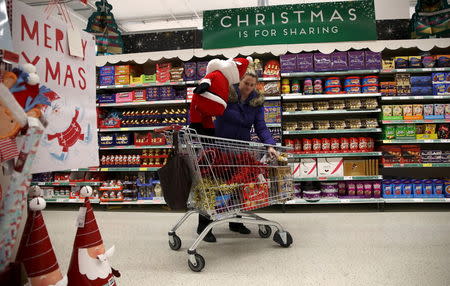Dinosaurs stirring - UK's hypermarkets show signs of life
By James Davey LONDON (Reuters) - The vast out-of-town British supermarkets that were written off as millstones around the neck of the industry just 12 months ago are showing signs of coming back to life, bringing a glimmer of hope to the ailing sector. All of Britain's big four grocery chains – market leader Tesco , Sainsbury's , Wal-Mart's Asda and Morrisons – have seen sales, profits and asset values hammered by a price war, sparked by changing consumer habits. One of the biggest drags has been the mega stores of up to 120,000 square feet that sprung up in the 1990s but were deserted during the economic downturn as shoppers chose more regular visits to discounters, local shops and online sites. However, Tesco and Sainsbury's have recently shown some stabilisation, helped by improvements at the biggest stores. "They're not dinosaurs," Sainsbury's Chief Executive Mike Coupe told Reuters but said the stores need to be reinvented. Recent changes, designed to stem the loss of shoppers to German discounters Aldi [ALDIEI.UL] and Lidl [LIDUK.UL], include lower and more stable prices, better product availability, and more staff on the shop floor. Attempts are also being made to draw customers in by using excess space for non-food products, such as clothing, and striking deals with third-party concessions, selling goods such as photography equipment, sportswear and jewellery. PRESSURE EASING? There is evidence the pressure on Tesco and Sainsbury's big stores may be starting to ease. In the third quarter of Tesco's 2014-15 financial year underlying sales at its estate of 250 "Extra" stores, which can be up to 120,000 square feet, slumped 6.3 percent. Fast forward three quarters and the like-for-like sales fall for the format in the second quarter of its 2015-16 year was just 1.1 percent. An improvement from down 6.1 percent to down 2.3 percent was also seen at Tesco’s 479 "Superstore" outlets, which are typically about 30,000 square feet. Similarly in its last two quarters Sainsbury's, whose larger stores are on average smaller than Tesco's, has highlighted an improvement in the number of products bought in its core estate of 599 supermarkets, which are typically 40,000-60,000 sq ft. Having fallen for over four years it has now flattened out and industry data published last month showed the firm registering the first market share gain of any of Britain's big four grocers since October 2014. In six Sainsbury's supermarkets Coupe is trialling new formats, including radically different store layouts and more checkout options. Learning from the success of the smaller, convenience stores, the idea is to make it quicker and easier to shop, with the additional benefit of huge choice. "All of those people that were saying the death of the hypermarket. No, it's not the case," said Tesco CEO Dave Lewis. "As we've gone back to giving shoppers the full choice and increasingly better value (they've realised) that's the most convenient way to do your shopping." He noted that 76 percent of Tesco convenience trips - where consumers buy only a small basket of products - now take place in its Extras or Superstores. The improvement suggests Tesco and Sainsbury's, the two biggest players, may be starting to reassert themselves in a market turned upside down by the rapid growth of the discounters. That leaves a bigger question mark over the prospects of Asda and Morrisons, the current laggards of the sector, the latter of which recently lost its status as a member of Britain's FTSE 100 index of blue chip companies. Tesco reported an annual loss of 6.4 billion pounds this year, one of the biggest in British corporate history, and also manipulated its results as the pressure built in the sector. VIRTUE OF NECESSITY The reality is that with so many big stores Britain's grocers have to make a virtue of necessity. "Ultimately, they have to turn those bigger stores around. I don't think they can recover without those stabilised," said an institutional investor in both Tesco and Sainsbury's. Naysayers point out that big store sales, on a value basis, are still falling, just less quickly, and argue that the data showing an improving trend is flattered by the inclusion of products picked in store for online deliveries. They say a tough Christmas quarter for Tesco could dent the improving trend. They also note that with Aldi and Lidl both having huge pipelines of new stores, the UK grocery market share of the German discounters is forecast to increase from the current 10 percent to about 15 percent by 2021, with Britain's big four grocers likely to bear the brunt. But there are other reasons to be more optimistic. The increase in UK consumers' disposable income could eventually translate into a rise in grocery sales at big stores if it means consumers value saved time more than saved money. Prices in the shops could also start to rise if tumbling commodity prices ease, while lower fuel costs should encourage shoppers to return to their cars. Analysts also see big stores inextricably linked with the growth in the online grocery market as products are picked from stores for home delivery, while "click and collect" at stores is also gaining in popularity. And looking further out the fact that the major grocers have halted big store openings should help the existing stores as Britain's population rockets by about 10 million over the next 25 years, according to official estimates. Coupe reckons that even in the most pessimistic scenario, well over half the grocery shopping in the UK will be done in large out of town superstores in seven years time. "We see a time on the horizon where sales start to rise in superstores, margins build and cash flows, because there's no more capital expenditure, could be prodigious," said Shore Capital analyst Clive Black. "So those superstores may be worth investing in again." (Editing by Kate Holton and Anna Willard)

 Yahoo News
Yahoo News 

